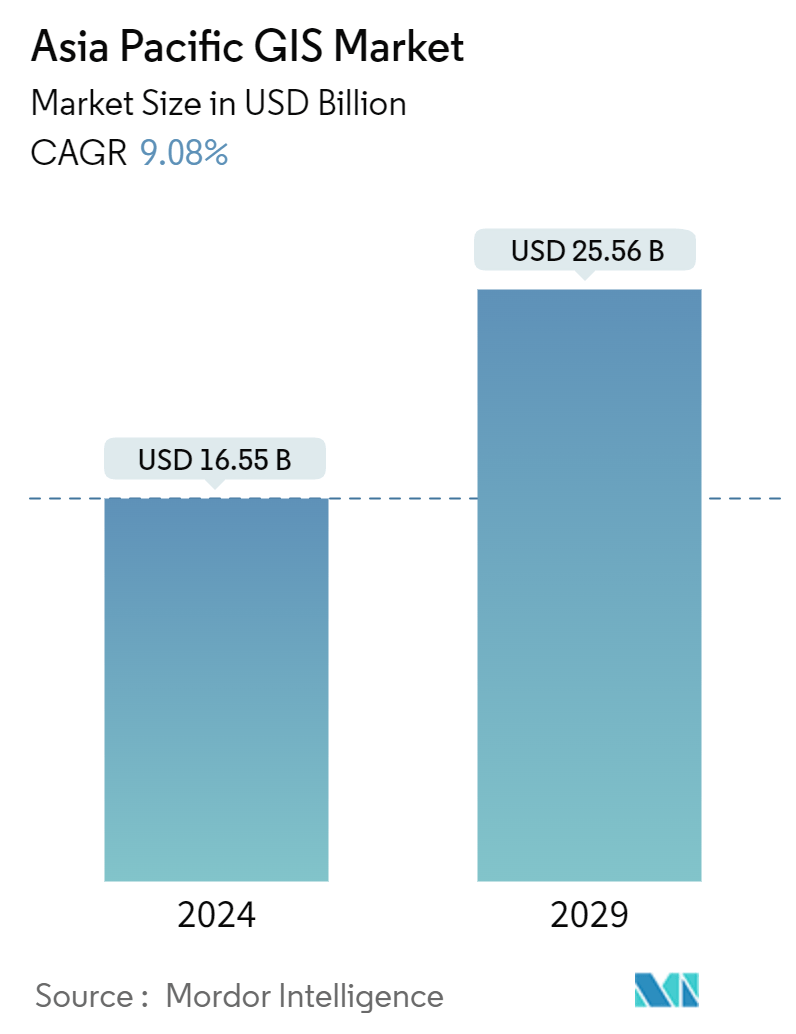Market Size of Asia Pacific GIS Industry

| Study Period | 2019 - 2029 |
| Base Year For Estimation | 2023 |
| Market Size (2024) | USD 16.55 Billion |
| Market Size (2029) | USD 25.56 Billion |
| CAGR (2024 - 2029) | 9.08 % |
| Market Concentration | Low |
Major Players
*Disclaimer: Major Players sorted in no particular order |
Asia Pacific GIS Market Analysis
The Asia Pacific GIS Market size is estimated at USD 16.55 billion in 2024, and is expected to reach USD 25.56 billion by 2029, growing at a CAGR of 9.08% during the forecast period (2024-2029).
The Asia-Pacific GIS market is experiencing robust growth driven by increasing demand for location-based services, government initiatives for infrastructure development, and the rising adoption of GIS in various industries.
- Advancements in geospatial technologies, including cloud-based GIS solutions and real-time data analytics, enhance market growth. Integrating GIS with emerging technologies like IoT and AI creates new opportunities for market players. The Asia-Pacific GIS market is poised for continued growth, driven by evolving customer needs and technological innovations.
- In the sustainable energy sector, GIS technologies are utilized to assess the availability and plan and successfully create renewable energy projects. The rise in renewable energy projects is expected to drive the market studied. According to the Clean Energy Council (CEC), Australia added 5.9 GW of renewable capacity to the grid in 2023, up from 5 GW in 2022. Rooftop solar contributed 3.1 GW, while utility-scale projects added 2.8 GW. This marked an increase from 2022 when rooftop solar provided 2.7 GW, and utility-scale projects contributed 2.3 GW.
- GIS maps can analyze and optimize the whole supply chain, from raw materials to end products. By mapping the flow of materials and goods, one can identify inefficiencies and bottlenecks and drive strategic decisions to enhance the efficiency and cost-effectiveness of the supply chain. GIS solutions can provide inputs on vehicle capabilities, consumers' and intermediaries' availability time windows, and additional information required for creating the most efficient routes and schedules.
- The rise in investments in the maritime sector in the region might create an opportunity for the market to grow. For instance, the Australian government is expected to invest USD 64 million over the next four years, including USD 40 million in new funding, to enhance Australia's Southeast Asia maritime partnerships.
- The market is witnessing strategic partnerships, product launches, and investments by key players as part of its crucial strategy to improve business and their presence to reach customers and fulfill their requirements for various applications. In September 2023, Orbica introduced the Roadshow, the Geospatial Platform, which combines AI, AWS Cloud, and geospatial technologies.
Asia Pacific GIS Industry Segmentation
Geographic Information Systems (GIS) store, analyze, and visualize data for geographic locations on the Earth's surface. GIS is a computer-based tool that investigates spatial patterns, relationships, and trends. GIS better understands data employing a geographic context by connecting geography with data.
The Asia-Pacific GIS market is segmented by country (Australia, Singapore, Indonesia, Malaysia, Bangladesh, and the Rest of Asia-Pacific). The market sizes and forecasts are provided in terms of value (USD) for all the above segments.
Asia Pacific GIS Market Size Summary
The Asia-Pacific Geographic Information System (GIS) market is experiencing significant expansion, driven by the increasing demand for location-based services and government initiatives focused on infrastructure development. The market is benefiting from advancements in geospatial technologies, such as cloud-based solutions and real-time data analytics, which are enhancing its growth prospects. The integration of GIS with emerging technologies like IoT and AI is creating new opportunities for market players. The market's growth is further supported by the rising adoption of GIS across various industries, including sustainable energy, where it is used to assess and plan renewable energy projects. The maritime sector's investment in the region also presents growth opportunities for the GIS market.
In Australia, the GIS infrastructure is well-developed, with initiatives like the Australian Spatial Data Infrastructure (ASDI) supporting advanced policies and technologies. The market is characterized by strategic partnerships, product launches, and investments by key players aiming to enhance their presence and meet customer demands. The increasing shift towards cloud-based solutions is driving the adoption of on-demand security services, with companies like VMware and Microsoft expanding their cloud infrastructure in the region. The market is fragmented, with major players such as Autodesk Inc., Bentley Systems Incorporated, and Google LLC actively engaging in partnerships and acquisitions to gain a competitive edge. These developments, along with the use of GIS in agriculture, civil engineering, and government planning, are contributing to the market's robust growth trajectory.
Asia Pacific GIS Market Size - Table of Contents
-
1. GEOGRAPHIC INFORMATION SYSTEMS (GIS) – MARKET INSIGHTS
-
1.1 Australia
-
1.2 Singapore
-
1.3 Indonesia
-
1.4 Malaysia
-
1.5 Bangladesh
-
1.6 Rest of Asia-Pacific
-
Asia Pacific GIS Market Size FAQs
How big is the Asia Pacific GIS Market?
The Asia Pacific GIS Market size is expected to reach USD 16.55 billion in 2024 and grow at a CAGR of 9.08% to reach USD 25.56 billion by 2029.
What is the current Asia Pacific GIS Market size?
In 2024, the Asia Pacific GIS Market size is expected to reach USD 16.55 billion.

